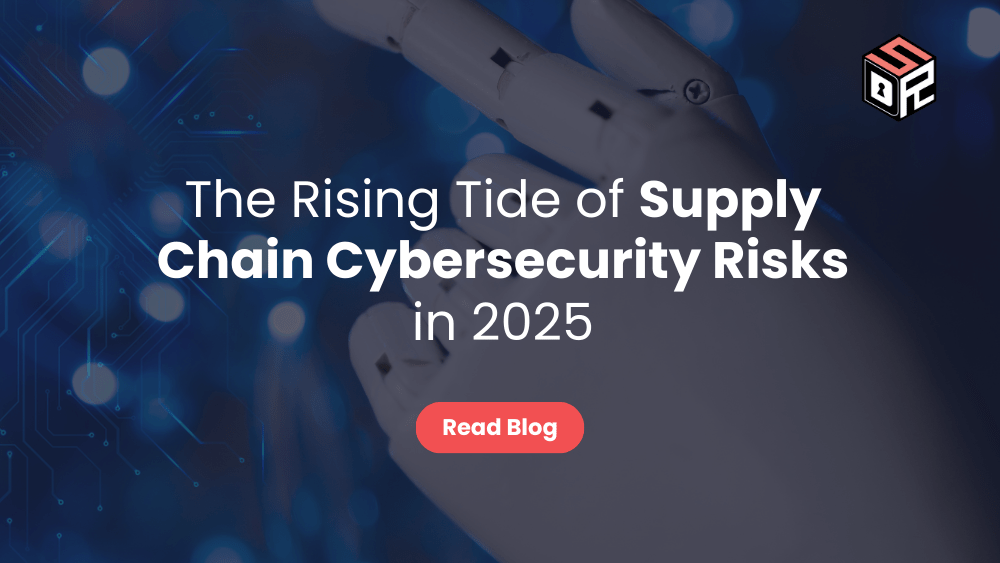As global supply chains become increasingly interconnected and technology-dependent, they also become more exposed to evolving cyber threats. From the exponential rise in connected devices to the rapid evolution of quantum computing, 2025 is shaping up to be a pivotal year. For CISOs, IT leaders, and supply chain managers, proactive cybersecurity strategies are no longer optional—they are essential.
This blog explores the top six Supply Chain Cybersecurity Risks in 2025, unpacking the latest trends and emerging threats.
1. Quantum Computing: A Double-Edged Sword for Encryption
What is Quantum Computing?
Quantum computing uses principles of quantum mechanics—specifically superposition and entanglement—to perform computations exponentially faster than classical computers. In 2025, many global bodies, including the United Nations, have dubbed it a “transformational year” for quantum advancements.
Quantum Computing and Cybersecurity Threats
While the innovation is revolutionary, Quantum Computing and Cybersecurity are at odds when it comes to encryption. Classical encryption methods, such as RSA and ECC, rely on the computational difficulty of factoring large integers. Quantum algorithms like Shor’s algorithm render these protections vulnerable.
Implications for Supply Chains
- Post-Quantum Cryptography in Supply Chains becomes vital to defend sensitive data.
- If bad actors acquire quantum capabilities, they could break current encryption and exfiltrate trade secrets, supplier contracts, and shipment records.
- Enterprises relying on VPNs, TLS, and public-key infrastructures must begin migrating to quantum-resilient algorithms as recommended by NIST.
2. IoT: Expanding Attack Surfaces in the Smart Supply Chain
Why IoT Matters to Logistics
In 2025, the global Internet of Things (IoT) market is projected to surpass $77 billion, much of which is driven by Cybersecurity in Smart Supply Chains. IoT enables real-time tracking, predictive maintenance, and automated inventory management.
IoT Cybersecurity Risks
However, more endpoints mean more vulnerabilities. Weak APIs, insecure firmware, and outdated backend protocols increase risk exposure.
Key threats include:
- Hijacked devices used for botnets or DDoS attacks
- Intercepted sensor data altering shipment or inventory records
- Unauthorized access through compromised gateways
Cybersecurity for Connected Devices
To mitigate IoT Cybersecurity Risks, supply chains must:
- Enforce zero-trust architecture for device communication
- Implement regular OTA (Over-The-Air) security patches
- Adopt end-to-end encryption for IoT data streams
3. Ransomware: The Relentless Threat to Supply Chains
Surge in Attacks
2025 has already seen a spike in Ransomware in Supply Chains, especially from Ransomware-as-a-Service (RaaS) affiliates. Groups like Medusa have ramped up attacks, breaching over 400 organizations since 2023 and causing upwards of $15 million in damages.
How RaaS Changes the Game
RaaS lowers the barrier for cybercriminals by offering ransomware kits and infrastructure for a profit share. This decentralizes cybercrime, making it harder to trace and stop.
Key developments:
- Customizable payloads targeting SCADA and ERP systems
- Encryption of logistics platforms, halting global shipments
- Double extortion tactics—data theft followed by system lockouts
Mitigation Strategies
- Implement immutable backups and air-gapped systems
- Train staff in phishing detection
- Use AI-driven threat detection to identify anomalies in real time
4. Robotics: A New Frontier for Cyber Intrusion
Robotics in the Supply Chain
From picking and packing to fleet management, robotics is reshaping logistics. By reducing labor costs and increasing efficiency, they’re indispensable—but also vulnerable.
Robotics Security in Logistics
Robots in warehouses and manufacturing lines are packed with sensors, cameras, and proprietary algorithms, creating rich data pools that attract attackers.
A 2024 study in Cyber Security and Applications found:
- Malware can corrupt robot firmware, leading to shutdowns or sabotage.
- Remote-access vulnerabilities enable control hijacking.
- Sensitive data leaks from unsecured robot telemetry.
Cyber Defense for Robotics
- Restrict remote access to robotics systems using MFA and RBAC
- Segment networks to isolate robotic systems from corporate infrastructure
- Regularly scan and patch vulnerabilities in robot operating systems
5. AI-Driven Cyberattacks: Smarter Threats Require Smarter Defense
The Dual Role of AI in Supply Chains
Artificial Intelligence (AI) is streamlining supply chain functions such as demand forecasting, route optimization, inventory tracking, and warehouse automation. However, just as AI empowers operations, it also fuels AI-driven cyberattacks that are faster, more adaptive, and harder to detect.
The Rise of AI-Powered Malware
One of the most alarming developments in 2025 is the surge in AI-powered malware. These malicious programs can:
- Learn from their environment and adapt in real time.
- Evade traditional antivirus software using polymorphic code.
- Auto-target vulnerabilities in logistics software and connected devices.
A recent survey revealed that 91% of cybersecurity experts expect these attacks to dominate the threat landscape by the end of the decade.
Deepfakes and Social Engineering
Another aspect of AI-Driven Cyberattacks is social engineering through:
- Deepfake videos and voice impersonation of supply chain managers.
- Hyper-personalized phishing emails designed to bypass spam filters.
- Synthetic identities used to gain fraudulent access to logistics platforms.
Defense Against AI-Driven Threats
- Use behavioral AI detection systems that identify anomalies instead of static signatures.
- Implement continuous security training to detect AI-powered impersonations.
- Deploy zero-trust access models for suppliers and third-party partners.
6. Geopolitical Cyber Threats: The Invisible Hand Disrupting Global Trade
The Political Dimension of Cybersecurity
The global supply chain does not exist in a vacuum. It is vulnerable to geopolitical cyber threats, especially in 2025, as tensions flare across regions. Cyberattacks are increasingly used as tools of political leverage or retaliation.
State-Sponsored Cyberattacks on Supply Chains
Countries now routinely launch state-sponsored cyberattacks targeting critical logistics infrastructure. For instance:
- The Volt Typhoon attacks, publicly attributed to Chinese actors in late 2024, targeted U.S. critical infrastructure, including maritime logistics platforms.
- Nation-state actors have deployed custom malware, embedded backdoors, and exploited zero-day vulnerabilities in supply chain software.
These attacks disrupt:
- Shipping logistics through compromised port systems
- Manufacturing timelines by disabling machinery controls
- Communication across partner ecosystems via ransomware campaigns
In the face of rising geopolitical cyber threats, diplomatic coordination has become as crucial as technological defense. The United Nations’ 2024 cybercrime convention—the first global treaty aimed at harmonizing laws and norms around cybercrime—represented a historic milestone. This agreement provided a unified legal framework for prosecuting cybercriminals and introduced guidelines for cross-border cyber incident response and cooperation.
However, while the intent is commendable, enforcement remains uneven. Many countries, particularly those with strained geopolitical ties or competing digital sovereignty ideologies, have not signed the treaty. These non-signatory nations continue to serve as operational bases for state-sponsored cyberattacks and criminal organizations using Ransomware-as-a-Service (RaaS) models.
In 2025, international tensions are further complicating matters. Cyberattacks are increasingly being used as tools of political pressure, economic sabotage, and even low-grade warfare. The Volt Typhoon cyber campaign, recently attributed to Chinese state-backed actors, highlighted how state-sponsored cyberattacks can directly target critical infrastructure, disrupting supply chains and creating ripple effects across global logistics.
Cybersecurity Diplomacy Today:
- The U.S.–China digital standoff has escalated, with both nations investing in post-quantum cryptography to stay ahead of adversarial decryption attempts.
- The EU has pushed forward the NIS2 Directive, increasing the requirements for reporting and mitigating cyber incidents across supply chain operators.
- Meanwhile, regional alliances like ASEAN and the African Union are slowly building unified cybersecurity postures but still lack the capacity to enforce advanced digital defense standards.
What Can Be Done?
With Supply Chain Cybersecurity Risks 2025 intensifying under the pressure of geopolitical conflict, industry leaders and governments must take proactive and multi-pronged action:
1. Establish Cyber Threat Intelligence Sharing Agreements
- Join or form multinational consortia for cyber threat intelligence (CTI) sharing.
- Use platforms like FIRST, ISACs, and MITRE ATT&CK to exchange indicators of compromise (IOCs), malware signatures, and geopolitical attack motivations.
- Prioritize threat data regarding state-sponsored cyberattacks and APT groups known to target logistics, defense, and transportation sectors.
2. Monitor for APT Groups with Geopolitical Motivations
- Deploy behavioral threat detection and AI-powered malware analysis to track stealthy campaigns.
- Watch for attacks using AI-driven cyberattacks, including deepfakes or synthetic communications that impersonate diplomats, executives, or supply chain coordinators.
- Partner with MSSPs or internal red teams to simulate geopolitically motivated breach scenarios and tighten defenses.
3. Build Redundant Systems Across Geopolitical Zones
- Avoid overreliance on infrastructure or cloud services hosted in politically unstable regions.
- Use geographic load balancing to replicate critical digital infrastructure (DNS, databases, CI/CD pipelines) across regions.
- Consider zero-trust architecture for data access, especially when working with third-party suppliers in high-risk countries.
Why This Matters:
Cybersecurity in smart supply chains doesn’t just depend on firewalls or software updates—it now hinges on the stability of global diplomacy and cooperation. Without unified action, cybercriminals will continue exploiting IoT cybersecurity risks, leveraging quantum computing and cybersecurity weaknesses, and hiding behind jurisdictional shields.
Safeguarding the Smart Supply Chain in 2025
With all these evolving threats, Cybersecurity in Smart Supply Chains must be more robust than ever. Here’s a holistic approach:
Supply Chain Cybersecurity Checklist for 2025
1. Embrace Post-Quantum Cryptography
- Migrate encryption standards as per NIST’s PQC recommendations
- Test quantum-safe algorithms for critical communications
2. Harden IoT Infrastructure
- Conduct regular vulnerability assessments on connected devices
- Implement end-to-end device authentication
3. Fortify Ransomware Resilience
- Schedule daily encrypted backups
- Develop and rehearse a ransomware response plan
4. Secure Robotics at the Firmware Level
- Disable unnecessary ports and services
- Monitor robot activity logs for unusual behavior
5. Use AI to Fight AI
- Leverage AI-powered defense systems to combat dynamic malware
- Automate SOC (Security Operations Center) response playbooks
6. Integrate Geopolitical Threat Awareness
- Subscribe to nation-state threat feeds
- Run simulated red-team exercises against geopolitical attack scenarios
FAQs: Supply Chain Cybersecurity Risks 2025
What are the biggest supply chain cybersecurity risks in 2025?
The top threats include quantum computing vulnerabilities, IoT insecurity, ransomware, robotics hacks, AI-driven attacks, and state-sponsored cyber threats.
How is quantum computing affecting cybersecurity?
Quantum computing can break traditional encryption algorithms, making supply chain data vulnerable unless post-quantum cryptography is implemented.
Why is AI a cybersecurity risk for supply chains?
AI can be used to automate attacks, evade detection, and create deepfakes that trick employees into handing over sensitive credentials or funds.
What makes ransomware more dangerous in 2025?
Ransomware-as-a-Service (RaaS) has lowered the technical bar for launching attacks, making them more frequent and harder to trace.
How can companies defend against geopolitical cyber threats?
By diversifying infrastructure, monitoring global threat intelligence, and building redundant systems outside conflict zones.









